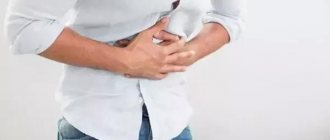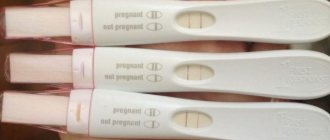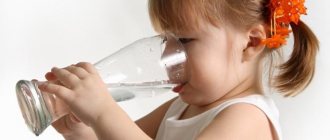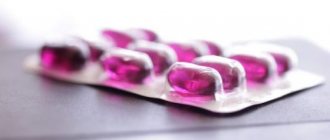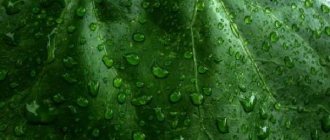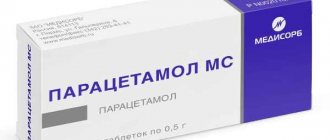Infantile roseola (sudden exanthema)
Herpes virus type 6 (HHV-6) causes roseola infantum (sudden exanthema). Temperatures above 39°C last for 3-4 days, temperatures below 39°C can last up to 8 days. After a drop in temperature, a bright macular or maculopapular rash appears on the skin of the face, neck or torso. The rash does not itch. Sometimes the cervical lymph nodes are enlarged, swelling around the eyes and red papules on the soft palate (Nagayama spots). Fever may be accompanied by diarrhea, cough, runny nose and headache. The rash goes away in 3-4 days without treatment.
Important!!! The rash that appears after the temperature normalizes is frightening: “First the temperature, and now the rash!” In fact, this is a sign of the end of the disease.
Febrile seizures in children under 2 years of age, fever without a focus of infection, and Epstein-Bar negative mononucleosis are often caused by herpes virus infection type 6 (HHV-6). In rare cases, the virus causes fulminant hepatitis and encephalitis, as well as Rosai-Dorfman syndrome (generalized lymphadenopathy).
| Photo. Infantile roseola (sudden exanthema): bright macular and maculopapular rash; herpetic sore throat with ECHO exanthema. | |||
ECHO-exanthema (infectious exanthema) proceeds similarly - the rash appears after the temperature normalizes. With ECHO exanthema, herpetic sore throat and diarrhea are common.
About baby roseola, see Rash after fever and nothing more.
The child is vomiting snot
Rotavirus infection, characterized by such, at first glance, completely incompatible symptoms. like runny nose, cough, fever, diarrhea, it is extremely contagious and therefore very common.
Half of all gastrointestinal disorders in a small child can be associated with it. A baby can “catch” it not only like a regular flu, through airborne droplets, but also through unboiled water or dirty hands.
Rotavirus is a rather dangerous disease, since its causative agent is very “strong”. It poses a threat to anyone who comes into contact with a sick person, but this infection most quickly affects weakened people: children, the elderly or those who suffer from chronic diseases.
It is they who can die due to this disease. The incubation period for rotavirus is very short - only 12 hours.
Publication date: April 11, 2020.
The reasons for the appearance of such symptoms on a child’s body can be very different. Only a specialist should make a diagnosis and prescribe treatment. Otherwise, you can only aggravate the already not very good condition of your baby, as well as blur the symptomatic picture, which will complicate the doctor’s work in identifying the disease.
Sudden weakness, drowsiness, pallor, lethargy of the child, loss of appetite are the first signs of the disease. But they are not specific and can accompany a variety of diseases.
Having noticed these symptoms, you need to try to understand what else is bothering the child, what is wrong. Based on a combination of various symptoms, doctors diagnose the child.
So that your baby’s illness doesn’t take you by surprise, let’s find out what signs you can use to recognize it.
Firstly, fever is one of the most common symptoms of the disease. A normal temperature for a child is considered to be between 36.0 and 37.0°C.
But as practice shows, infants are prone to overheating and hypothermia. This depends on many factors: on how the baby is dressed, on the temperature in the room, on the activity of the child himself - the temperature can rise with anxiety or during play.
Therefore, the boundaries of normal temperature can be expanded: 35.8-37.2°C. Fever is usually a sign of an infectious disease (ARVI, influenza, childhood infections, meningitis, intestinal infections, etc.).
d.).
Look into the eyes If the child has clean and clear eyes, then there is no need to worry too much. If you notice that yellow substance is accumulating in the corners of the eyes, and your baby's gaze has dimmed, this is a cause for concern.
Festering eyes can be either a sign of a cold or indicate inflammatory processes in the ear area. Redness of the eyeballs in the absence of a runny nose may be a sign of conjunctivitis.
In any case, it is advisable to show the child to the doctor.
This pathological process occurs quite often among children under the age of five. The thing is that their body has not yet fully adapted to all the food that adults offer it.
One of the most dangerous diseases is meningococcal infection. It can occur not only in childhood, but also in adults. The main sign of the disease are tiny bubbles that are located on the back wall of the larynx. At the same time, they look like hemorrhages.
Meningitis is also characterized by other symptoms such as:
VASHE ZDOROVIE / 21.06
In the first years of life, children are most susceptible to various diseases. This is due to a weak immune system and an irresistible desire to explore the world by touching everything you like, including on the street.
Even if the child regularly takes multivitamins, he observes the rules of personal hygiene. If he eats right, he is still susceptible to various diseases. One of these diseases is enterovirus infection in children, the symptoms of which are expressed in the form of high fever in the child. lack of appetite, bowel dysfunction, etc.
Enterovirus infection is a group of infectious diseases associated with each other. The causative agents of these diseases are intestinal viruses such as ECHO and coxsackie. These viruses are able to live for quite a long time in the external environment (on clothing, grass, dishes), in most cases they affect children over 2 years old and are seasonal in nature.
When entering a child’s body, an enterovirus infection first overcomes the incubation period (approximately 24 hours), and then begins to manifest itself in the form of the following symptoms of enterovirus infection in children.
Symptoms of enterovirus infection in children
Symptoms appear suddenly, acutely and sharply, without preliminary ailments. The child's body temperature rises sharply to 38 degrees or higher, and there is extensive redness of the skin (skin hyperemia) on the face or neck.
Sometimes the hyperemia can be widespread, and redness is observed on the limbs, torso and on the mucous membranes of the nose or throat. Sometimes high temperatures provoke fever in children, which lasts for several days and is paroxysmal in nature.
An increase in body temperature is accompanied by intoxication - evidence that an acute infection is raging in the child’s body. Toxins released by enterovirus infection cause nausea and vomiting.
At the same time, the child becomes very weak and his blood pressure drops. Cold sweat appears, and the skin of the face may take on a greenish tint.
Intoxication is dangerous due to dehydration, so during illness the child should be provided with plenty of fluids.
Enterovirus infection in children has symptoms that are sometimes similar to other diseases (for example, diseases caused by Escherichia coli). In acute inflammation, inflammation of the cervical lymph nodes (cervical lymphadenitis) may develop. The rapid development of enterovirus infection takes on various forms. Therefore, in addition to general symptoms, individual signs can be identified in children.
The development of herpetic sore throat, in which small elevations form on the oral mucosa, which increase over time and become covered with a white coating. In this case, the high body temperature lasts for several days.
The most common form of enterovirus infection in children manifests itself in the form of epidemiological myalgia. In this case, the general symptoms are complemented by pain in the muscles and chest.
The disease is wavy in nature.
When the nervous system is affected by infection, attacks of headaches, a weakened state of the child, dizziness, loss of consciousness and even paralysis are observed. With such symptoms, a form of serous meningitis develops.
In young children there is an intestinal infection. In this case, children suffer from loose stools. Symptoms of enterovirus infection in children of this form appear as follows:
- watery stools, sometimes mixed with mucus;
- rumbling in the stomach;
- profuse vomiting;
- a runny nose appears;
- swelling of the nasopharyngeal mucosa;
- bloating after eating;
- cough.
What to do if you have symptoms of enterovirus infection in children
If you observe signs similar to those of enterovirus infection in children, you should immediately seek help from a doctor. The infection is contagious and can spread to other younger family members, so the doctor prescribes isolation of the patient for at least 10 days.
Treatment takes place in the infectious diseases department. All the patient’s belongings and hygiene items must be thoroughly washed and disinfected to avoid spread and re-infection.
Please give more details and be more specific about what this is from?
To wash means to take a baby syringe, fill it with any solution or decoction (salt, chamomile, etc.), wrap the baby in a diaper (arms), sit him on his knees with his side to you, press his head with your hand, slightly tilting forward , insert a syringe into the nostril and squeeze the solution into the nose. The water should pour out from the other nostril.
Diarrhea at a young age, especially in infants, is accompanied by high body temperature and the appearance of a rash on the skin. During this period, the child’s body is sensitive to all changes, so the reaction to them is immediate.
In order to stop attacks of diarrhea as quickly as possible, it is necessary to seek help from a specialist as soon as possible, who can accurately identify the allergen and select a treatment regimen.
With food allergies, attacks of diarrhea and a rash on the body occur several hours after eating. Diarrhea is accompanied by high fever, pale skin, and bouts of vomiting alleviate the child’s condition to some extent.
This is why it is important to ensure that you drink plenty of fluids at all times. In addition, you should avoid immediately blocking diarrhea and vomiting, since in this way the body removes the toxins that caused this condition.
Before calling an emergency medical team, you must try to remove toxins from the child’s body and prevent dehydration. Under no circumstances should you give your baby fever-lowering medications for intestinal infections.
The best way to prevent this is rehydron. This is an absorbent drug that helps normalize the water-alkaline balance in the body.
It is diluted in boiled water at the rate of 1 sachet packet per 1 liter of water and given to the baby to drink after each bowel movement. For children over one year of age, enterosgel can be used, which is a good enterosorbent.
In case of poisoning with medicines and food, it is necessary to induce vomiting and rinse the stomach, give the child to drink absorbent drugs: activated carbon, white carbon, a weak solution of potassium permanganate.
If you experience diarrhea, pain in the lower abdomen as a result of the flu, or the baby constantly lies in a bent state, this is a reason to consult a doctor, undergo the necessary tests and, having received an accurate diagnosis of the accompanying problem, begin adequate treatment.
If a child suddenly starts vomiting, under no circumstances should he be put to bed after the first urge. This can cause vomit to enter the respiratory organs.
Very often, children refuse food after the main symptoms of the disease have disappeared. Under no circumstances should you force a child to eat.
He will still eat little by little, since a hungry body will require it. It is better to give him protein foods during this period: boiled beef, chicken, fish.
Fatty foods should not be given to children; they are poorly digestible. The baby's stomach was under enormous stress.
In order not to irritate his mucous membranes, you can give vegetables and fruits such as bananas, baked apples, and boiled potatoes. Eating porridges should be alternated with low-fat soups.
The phenomenon of diarrhea and vomiting without fever in children is observed quite often. It is quite natural that such a condition of the child causes anxiety among parents, especially if he is still very young.
Vomiting and diarrhea will not always indicate some serious illness, however, only a doctor can adequately assess the situation. Of course, parents should know the possible causes of the child’s condition, but this does not mean that they do not need to see a doctor.
Intestinal infection
Refusal of water and food.
Food poisoning
Dysbacteriosis
The child was vomiting and had a severe rash all over his body - what could it be?
Just yesterday, during breakfast (Nordic oatmeal on water), the child vomited everything, then vomited 3 more times within an hour, weakness and a severe rash appeared all over the body. Temperature is normal, stool is normal, - boy 1.10, has food allergies to some foods . By the time we got to the emergency room, the rash had gone away.
At home, after 2 hours I felt noticeably better, there was no more vomiting. At the emergency room they said it looked like poisoning - water with potassium permanganate, just water, chamomile decoction and smecta - all our treatment.
Now I’m thinking - what was that? Poisoned? But I can’t figure out what exactly. After all, a terrible allergic reaction appeared (though it also passed quickly)
Moms, what are your thoughts?
Loading.
We are already finishing the second pack of this porridge.
I didn’t notice anything extra there, nothing could have gotten in:/ I give milk porridge, but sometimes I make it with water
Thank you! But tell me, this doesn’t look like poisoning, does it? No diarrhea and fever.
And it all went by so quickly. It's just a severe allergic reaction to something, right?
Maybe I found something on the floor.
Musya 12/28/2009 at 11:53:13
It's like poisoning
In case of poisoning, fever and diarrhea are completely unnecessary. It depends on how you get poisoned. Couldn't he find some kind of pill on the floor? Or household chemicals?
literally before this, in the evening, I washed the kitchen floors thoroughly, but without chemicals
just water - so I have no idea what he could have found.
and about the poisoning - thank you - I thought that without diarrhea it wouldn’t be poisoning :/
Did you take a urine test?
Have you checked for acetone? very similar. Maybe buy test strips just in case. they are inexpensive.
How does the child feel now? Is the poop normal? if the smell is bad and there is a lot of undigested fiber, then there may have been acetone. then diet and enzymes for the pancreas. It’s better to do a urine and blood test. and then let the doctor look.
no, they didn’t donate urine or blood. I should, thanks!
I haven’t come across acetone, so I don’t have a test, I’ll definitely buy it now.
the child is cheerful and cheerful, as usual. I became like this by the evening after what happened
the stool was the next day, absolutely normal for us - nothing extra
you know, once as a teenager I was poisoned by nail polish remover.
While I was washing off the nail polish with it, I inhaled. The result is vomiting, diarrhea, and headache. Maybe reb. I also inhaled something.
you see, I try not to leave it unattended at all
maximum - half a minute with a guarantee that he won’t eat/drink/break anything, etc. so I doubt it. I’m racking my brains, I definitely couldn’t breathe in anything.
Benefits of an account on UAUA.info
Your email
specified during registration
Benefits from accounting
Rubella
With rubella, the eyes are reddish, there is a slight runny nose and cough. General health does not suffer. Sometimes, violet spots (Forchheimer's spots) on the soft palate. The lymph nodes behind the ears and on the sides of the neck are greatly enlarged. A pinkish-red, small-spotted rash appears after the temperature rises to 37.0-37.7°C. The first to appear is a bright blush on the cheeks. Within a day, the rash covers the face, chest, abdomen, legs and arms. There is little rash in places of natural folds (folds). The rash becomes brighter after swimming. Itching is mild. After 5 days, the rash disappears without a trace. Older children and adults may experience joint pain.
| Photo. Rubella: pinkish-red, finely spotted rash, the elements of the rash do not merge; enlarged occipital lymph nodes; Forchheimer spots on the soft palate. | |||
Rash after poisoning
Getting rid of the symptoms of poisoning does not mean a complete cure. Damage to the intestinal wall and impaired liver function may appear as a rash after poisoning. This is a form of allergic reaction.
Causes of the rash
People experience food poisoning from poor-quality products that contain pathogenic microorganisms and exotoxins.
The causative agents of intestinal infections are salmonella, dysentery, Escherichia, Yersinia, and Campylobacter. Bacteria enter through infected products - milk, sausages, eggs, chicken meat, poorly washed fruits and vegetables (see.
Fruit poisoning), fast food products prepared without sanitary standards.
Once microbes enter the intestines, they cause an inflammatory response. Their waste products poison the body, symptoms of intoxication develop, which are manifested by vomiting and diarrhea. The epithelium in the intestines is sloughed off, and a large amount of fluid is lost.
The immune system responds with a reaction of leukocytes: their number in the blood increases. In response to cell damage, histamine, serotonin, and allergic reaction proteins are released. A rash appears when poisoned.
An allergic reaction may occur in a different way. Immune cells release active substances to toxic proteins that form immune complexes. They can cause damage to microvessels. This form of vasculitis is manifested by a rash that may appear after poisoning. The cause of the rash may be an allergic reaction that develops in a weakened body.
Read why weakness appears during poisoning: causes and treatment.
Find out what tests for poisoning help make an accurate diagnosis.
Types of rash in case of poisoning
Skin manifestations vary in appearance. The most common type of rash is urticaria. The rash from poisoning in the photo looks like a burn from nettles.
It can be located on any part of the body - on the stomach, back, elbows, forearms. Sometimes it is confused with prickly heat. The latter appears in areas of greatest sweating. Urticaria is characterized by itching.
If the effect of the allergen is not eliminated, the rash becomes more pronounced, the elements merge, and large areas of rash appear.
Sometimes the rash appears as red or pink spots that protrude above the surface of the skin. They are accompanied by itching, and peeling may occur. The rash may look like small bubbles with liquid transparent contents. After opening them, weeping erosions form, which are gradually covered with a crust.
Treatment of rash after poisoning
To prevent the appearance of a rash after poisoning, therapy begins at the stage of acute manifestations. To treat food poisoning use:
- sorbents (see Polysorb for poisoning);
- rehydration;
- antihistamines;
- probiotics;
- antibiotics;
- diet;
- local remedies for treating rashes.
Diet
Nutrition during the recovery period after poisoning should be gentle. Potentially allergenic foods should be avoided, even if there was no reaction to their consumption before poisoning. These include chocolate, citrus fruits, chicken, eggs, and whole milk. Fish contains a large amount of its own histamine, so it can also cause allergies.
Source: https://ugri-net.ru/syp-posle-otravlenija/
Measles
Important!!! There is NO measles without cough and conjunctivitis.
Measles begins with a high fever, severe runny nose, cough and conjunctivitis. After 2-3 days, small white-gray grains appear behind the cheek - Filatov-Koplik spots. On the 3-4th day of high fever, a pink-red spotted or maculopapular rash appears on the bridge of the nose and behind the ears. Elements of the rash tend to merge and turn pale when pressed. On the first day, the rash affects the face, the second day - the torso, the third day - the legs and arms. When the rash appears on the extremities, on the face it already fades - it becomes burgundy-brown with isolated hemorrhages and peeling. Feet and palms do not peel off during measles. Itching is mild.
| Photo. Measles: measles conjunctivitis; Filatov-Koplik spots look like grains of salt; measles rash first appears around the ears; elements of the rash tend to merge. | |||
| Photo. Measles: on the first day the rash covers the face; the facial expression during measles is pained; the rash fades - acquires a brown tint, peeling appears. | |||
See more about measles: Fever, cough, conjunctivitis, rash - this is measles
Red spots on the face due to poisoning. Skin redness: main factors and causes
It should be understood that red spots on the face after alcohol have nothing in common with the usual blush, which does not cause any harm to the body. In addition to physiological differences (impaired heat exchange, increased heat transfer due to vasodilation), an allergy to alcohol often manifests itself many times more strongly: redness can even become crimson in color.
There are several main reasons for this phenomenon:
- The consequences of long-term alcohol abuse are alcoholism and chronic alcoholism. Constant exposure to ethyl alcohol on blood vessels leads to blockage, decreased elasticity, and the formation of congestion. Inflammatory processes occur in the body, affecting the capillaries and skin.
- Congenital alcohol intolerance. It is quite rare, but not so rare as to immediately exclude this cause from the possible factors in the occurrence of allergy symptoms.
- A standard reaction to alcohol entering the body. Due to the individual characteristics of the body (including light skin), it can manifest itself quite actively, especially if there are other factors contributing to the dilation of blood vessels. An unexpectedly strong reaction is also possible if an amount of alcohol has been drunk that significantly exceeds the norm.
An allergic reaction to alcohol or individual components of alcoholic beverages (dyes, flavorings, strong allergens such as almonds in liqueurs and others). Initially, it may manifest itself as slight redness, but over time it becomes more active, and the symptoms of an allergy to alcohol become more noticeable. People with a predisposition to allergic reactions should first pay attention to this reason.
Erythema infectiosum (parvovirus B19 infection)
Against the background of a low temperature, a spotted, papular and even urticarial rash appears. Parvovirus infection is often mistaken for hives. BUT!!! Antihistamines and systemic glucocorticosteroids are ineffective for parvoviral exanthema. First, a bright, macular rash appears on the face (a symptom of “slapped cheeks”), then a maculopapular rash appears on the extremities (including the palms and soles) and torso. The nasolabial triangle is usually pale. Itching is mild. Joints often hurt. The rash of erythema infectiosum may reappear after disappearing.
Important!!! Parvovirus B19 infection is dangerous for children with aplastic anemia, because it causes a transient aplastic crisis.
| Photo. Erythema infectiosum (parvovirus infection): a bright, patchy rash on the face that looks like slap marks—a symptom of “spanked” cheeks; the nasolabial triangle remains pale; a maculopapular rash on the body takes on a mesh-like shape. | |||
Scarlet fever
Scarlet fever is caused by some strains of group A hemolytic streptococcus. Scarlet fever occurs at high temperatures in the form of a sore throat with a pinpoint rash against the background of a hyperemic rut. Pale nasolabial triangle. A “raspberry” tongue is characteristic. On the 7-10th day, lamellar peeling of the hands and feet develops. These signs are quite characteristic for the diagnosis; it is confirmed by the release of GABHS or an increase in ASLO. Neutrophilic leukocytosis is common.
| Photo. Scarlet fever: sore throat; pinpoint rash; pale nasolabial triangle; raspberry tongue. | |||
| Photo. Scarlet fever: pinpoint rash; lamellar peeling of the palms and feet. |
Treatment of scarlet fever: penicillin or ampicillin intramuscularly, amoxicillin orally 50 mg/kg per day (Flemoxin Solutab). About scarlet fever, see Temperature, sore throat, rash - scarlet fever.
Neurotic reasons
Rash and diarrhea can occur in adults or children as a consequence of stress or a neurological disorder. You can suspect it based on the accompanying signs:
- irritation and anxiety;
- insomnia or difficulty falling asleep;
- reluctance to make contact with other people;
- The child is constantly crying or scared.
If a child's diarrhea becomes almost the same as water, then the reason lies in the excessive amount of liquid. The stomach simply does not have time to cope with its absorption.
But if a rash, vomiting and nausea are added to such a symptom, then this is a sign of bacterial infection. Additionally, the child is plagued by bloating and flatulence.
Borreliosis
Borreliosis (Lyme disease) is caused by the spirochete Borrelia burkdorferi, transmitted by the ixodid tick. The area of migrating erythema around the tick bite reaches 5-15 cm, sometimes with satellites, it migrates during the febrile period (up to 1 week) and is sometimes accompanied by conjunctivitis, headache, and arthralgia. After 3-12 months, damage to internal organs develops.
| Photo. Borreliosis: an area of erythema migrans around a tick bite. | |||
Treatment of borreliosis. Children under 8 years old - amoxicillin 50 mg/kg per day, over 8 years old - doxycycline (Unidox Solutab 100 mg 2 times a day) for 10-14 days, if symptoms persist - another 7 days or more. Organ lesions are also treated; in case of severe damage to the heart and central nervous system, ceftriaxone is administered (75-100 mg/kg once a day) for 14-21 days.
Vesicular rash in the form of blisters and blisters filled with fluid, pus or blood.
Chickenpox
The diagnosis of chickenpox is obvious when a characteristic rash appears against the background of a high temperature. Over the course of 2-4 days, the rash evolves sequentially (vesicle-pustule-crust).
| Photo. Chickenpox: the rash evolves sequentially (vesicle-pustule-crust). | |||
Treatment for severe forms of chickenpox: acyclovir intravenously - 40-60 mg/kg per day in 3 infusions. Locally, Sitelium lotion (Aderma medicinal cosmetics) is effective for reducing itching. Prevention: vaccination with live chickenpox vaccine.
Chicken pox
One of the common infectious diseases, which is successfully tolerated by about 85% of the population in childhood, is chickenpox, or, as people say, chickenpox. The disease is characterized by the fact that the child’s temperature rises, then the rash appears in the form of red spots with a watery blister.
Initially, there are few rashes, but gradually there are more and more pimples, and they can also be observed on the mucous membranes of the child. The appearance of spots due to chickenpox is usually accompanied by severe itching, so the pediatrician's doctor may recommend antihistamines (except antipyretics).
The watery blister dries out after a few days and a crust forms on the skin. A baby who has chickenpox is considered contagious to others for two weeks: it is during this period that all the “sores” will dry out and disappear. After this, the child is considered recovered. Chickenpox is transmitted by airborne droplets, and this disease belongs to the category of infections that occur once in a lifetime.
During the course of the disease, careful hygienic care is especially important for a young patient: rashes must be regularly treated with drying agents. It is necessary to carefully ensure that the baby does not scratch itchy pimples, as suppuration is possible at the site of the rash. Otherwise, chickenpox threatens to develop into furunculosis, which can occur against the background of chickenpox.
The period of active rash lasts more than one day, therefore it is important to promptly treat a rash that appears again in a child, and the temperature can also persist during the first few days of the disease. After the appearance of new acne stops, as a rule, the child’s temperature readings normalize. From this moment on, the baby begins to recover.
We suggest you read: Dentist therapists, what do they do?
Herpes simplex virus (HSV)
If a person becomes infected with the herpes simplex virus (HSV) for the first time, aphthous stomatitis appears from the 2nd to 3rd day of illness against the background of a very high temperature. Children with atopic dermatitis have a widespread vesiculopustular rash (Kaposi's eczema). Vesicles in the mouth are located in groups and often merge; when they rupture, superficial ulcers with a pale bottom (aphthae) form. The rash continues for 5 days. Due to the soreness of the mucous membrane, children do not eat and drink well. Herpetic stomatitis can be complicated by bacteremia caused by Kingella kingae, with the development of purulent arthritis, osteomyelitis or endocarditis.
| Photo. Herpes simplex virus: superficial, pale-bottomed sores in the mouth (aphthae). | |||
Treatment of herpetic stomatitis: acyclovir at a dose of 15-20 mg/kg 5 times a day reduces the duration of virus shedding and speeds up recovery, although it is not necessary with normal immunity. Locally, rinsing with a mixture of a 2% viscous solution of lidocaine, diphenhydramine and maalox is most effective.
Consumer Reviews
Elena Landysh about La-Cri cream (flap.rf)
“La Cree is a new discovery for me this summer. I acquired it not just by accident, but unexpectedly. It so happened that the necessary “Psilo-balm” was not available in both nearby pharmacies, and there was no way to wait for it to appear in the morning. And the mosquitoes gnawed nobly, viciously and mercilessly. Having received information about the absence of Psilo-Balm, I was about to send my husband to go to another 24-hour pharmacy, but the pharmacist quickly suggested an alternative to this balm - La Cree cream from the pharmaceutical company. The cost of this product is around 250 rubles. Like a well-known competitor, so I didn’t gain or win money, but I hoped for a good result for this money.
The purpose of “La-Cri” (I’ll explain for those who don’t know about “Psilo-Balm”): a calming effect on sensitive skin suffering from itching, redness, and irritation. The name “La Cree” is, of course, unusual to my ears. I wonder what meaning the creator intended in this name?
The main difference between La-Cri cream and Psilo-balm is its natural herbal composition. There are extracts of string, avocado, licorice, walnut, violet, panthenol, bisabolol, and oils. The mix of ingredients is so gentle that the cream is approved for use by newborns. Yes, yes, the tube is marked “0+”. This is encouraging, because in the first years of their lives children have too many restrictions on medications, and they suffer no less than adults from environmental manifestations.
The volume of the tube seems to be small - 30 grams, but with rational use it lasts for a long time. The aroma of the cream is incomparable to my sense of smell! Herbal, with the addition of invigorating essential oil (judging by the composition, rosewood oil"). The color of the cream is also unusual - cream, such a tautology
The effect of La-Cri cream is immediate: the itching subsides instantly, the affected area of the body becomes less irritated, and overall the skin is moisturized. Great feeling! As if nothing had happened! Ehhh, I wish I had such a remedy in my childhood, otherwise who knows what they used to heal insect bites and reactions to some kind of herb. But my children are luckier, they are more comfortable, they are more protected.
A family friend came to visit us on vacation in the village - a purely city dweller, who had been to the dacha only a few times in his 30-odd years. Because of our busy nature, my friend got bites on the first day of his arrival, and after a trip to the forest and fishing there was even more irritation on his skin. And here I am with my La Cree! And no minor troubles from a rural holiday.
I’m pleased with the quality of the new product, so I recommend it!”
Yulia Nizovtseva about La-Cri cream (flap.rf)
“I’m not afraid to use it on my child’s redness, and I often use the cream myself. There is always a tube in the first aid kit just in case, and such cases happen very often. Especially in the summer, when it’s hot, there are irritations, heat rashes due to the heat, I apply the cream and everything goes away. I use it after a shower. I apply just a little onto the skin and after 5 minutes there is nothing left, the cream is easily absorbed and does not remain on clothes.
It smells nice, the texture is light, the composition is natural, it helps, what else is needed for children's skin? I’m glad that I chose Lacri cream; it cannot be compared with many children’s products.”
Sources:
- Kildiyarova Rita Rafgatovna, Pediatrician for every day. Guide for doctors, GEOTAR-Media, 2020.
- Andropova T.V., Gudina M.V., Odintsova I.N., Hygiene of children and adolescents, Siberian State Medical University Publishing House, 2020.
- Fundamentals of health development in children. Textbook. — Moscow: Mir, 2016.
- Tulchinskaya, V.D. Nursing assistance to children / V.D. Tulchinskaya. — Moscow: Russian State University for the Humanities, 2020.
Viral pemphigus of the mouth and extremities (mouth-hand-foot syndrome)
Viral pemphigus of the mouth and extremities (mouth-hand-foot syndrome) is caused by Coxsackie viruses (serotypes A4-A7, A9, A10, A16, B1-B3, B5) and enterovirus (type 71 and 19). First there is fever, fatigue and sore throat. Then bubbles appear on the mucous membranes of the cheeks, tongue, palate, gums and lips. On the hands and feet, papules turn into small blisters (3-7 mm in diameter), which burst, forming slightly painful erosions. The duration of the disease is 1 week, but the virus is excreted in the feces for several more weeks. For more details, see Fever, stomatitis, blisters on the arms, legs and buttocks - Coxsackie virus.
| Photo. Viral pemphigus of the mouth and extremities (mouth-hand-foot syndrome). | |||
Additional symptoms
Depending on the disease that caused the vomiting and fever, other symptoms will be observed:
- Headaches and muscle pain, dizziness, weakness, apathy.
- Strong crying, unusual postures, throwing back the head.
- Sharp or nagging pain in the stomach and intestines.
- Pale skin, profuse sweating.
- Lack of appetite.
- Cough, pain when swallowing, runny nose.
This is interesting: When should you donate blood for allergens? Purpose and decoding
Erysipelas
Erysipelas is an inflammation of the deep layers of the skin caused by group A beta-hemolytic streptococcus (GABHS). Against the background of high temperature, the skin has redness with clear contours and slightly raised borders. Swelling, tenderness, sometimes lymphangitis. Erysipelas often develops with nephrotic syndrome.
| Photo. Erysipelas: redness on the skin with clear contours and slightly raised borders; a bubble with serous-purulent contents often forms, which is then opened. | |||
Treatment of erysipelas: intravenous, intramuscular penicillin (100,000 units/kg per day), ampicillin (100-150 mg/kg per day), cefazolin (100 mg/kg per day), josamycin (or other macrolide).
Suppuration of subcutaneous and deep structures is accompanied by high fever and intoxication. Cellulite is an infiltrate of subcutaneous tissue, phlegmon is its suppuration (staphylococci, GABHS or H. influenzae type b). Necrotizing fasciitis of the deep tissues of the extremity is caused by GABHS. Myonecrosis (gas gangrene) - clostridia (C. perfringens, etc.). Characterized by skin hyperemia, swelling, soreness, with phlegmon - fluctuation; with fasciitis - pain and hyperesthesia with a “calm” picture of local changes; with myonecrosis - crepitus.
Treatment is aggressive, with antistaphylococcal drugs (oxacillin, vancomycin) and surgical treatment; for cellulite, fasciitis and myonecrosis - amoxicillin/clavulanate, ceftriaxone, carbapenems, linezolid, as well as clindamycin, metronidazole.
Scalded skin syndrome (Ritter's disease in newborns)
The disease is caused by toxins A and B of S. aureus (phagogroup 11, type 71). Bright erythema begins around the mouth, nose, and in parts of the body covered with a diaper; spreading quickly. The skin is very painful and flabby blisters form on it. With the slightest pressure, large areas of skin peel off. The skin looks like it's been burned. Nikolsky's symptom is positive. Healing in 1-2 weeks without scars.
| Photo. Scalded skin syndrome: bright erythema begins around the mouth and nose; with the slightest pressure large areas of skin peel off; the skin looks like it has been burned; healing in 1-2 weeks without scars. | |||
Treatment of scalded skin syndrome: intravenously or intramuscularly: oxacillin - 150 mg/kg per day or cefazolin - 100 mg/kg per day, alternative - vancomycin - 30-40 mg/kg per day, in mild cases - orally cephalexin - 50 mg/day kg per day, for allergies to lactams - clindamycin - 30 mg/kg per day or josamycin 50 mg/kg per day. In newborns, anti-staphylococcal immunoglobulin or plasma is also used. Locally: toilet with 0.1% solution of potassium permanganate, antibacterial ointments.
Urticarial rashes are blisters that are very itchy. The blisters disappear without a trace within a few hours.
Acute urticaria
In acute urticaria, there may be a fever. Urticaria must be differentiated from infectious rashes. Elements of true urticaria persist for no more than a day. The rash persists for more than 24 hours with urticarial vasculitis. This may be a symptom of a systemic disease. The blisters are pale pink. Large blisters have a white center and a reddish rim. The shape of the blisters is oval, ring-shaped, arched, bizarre.
| Photo. Acute urticaria: blisters are pale pink; Large blisters have a white center and a reddish rim. The shape of the blisters is oval, ring-shaped, arched, bizarre. |
Treatment of allergic urticaria is antihistamines and systemic glucocorticosteroids. Glucocorticosteroids are used only when there is a threat of death - Quincke's edema with laryngeal edema or bronchospasm. For intense itching, you can use hormonal creams and ointments locally.
Drug therapy
After identifying the cause that provoked the diarrhea and rash, medications are prescribed to relieve diarrhea, destroy the infection, reduce the temperature and prevent the development of dehydration:
- Enterosorbents: Smecta, Enterodes, Neosmectin.
- Antiemetics: Latran, Ceruglan.
- Antiviral: Arbidol, Kipferon.
- Antibacterial: Amoxicillin, Levomycetin.
- Antipyretics: Nurofen, Ibuprofen.
- Probiotics: Optilact, Linex.
- Saline solutions: Regidron.
- Vitamin and mineral complexes.
For chickenpox, the rashes are lubricated with antiseptic lotions (not brilliant green) to relieve itching and dry the wounds. The resulting crusts cannot be peeled off, as scars may remain. Patients are advised to take vitamins and follow a diet.
Rubella is a contagious disease for which there is no treatment. The child’s body itself suppresses the infection, developing a strong immunity to it. Allergic reactions require taking antihistamines: Suprastin, Zodak, Diazolin. In emergency cases, when swelling and difficulty breathing are observed, an ampoule of Dexamethasone is administered intramuscularly to the patient.
If diarrhea and rash appear in a child or adult due to drug therapy, it is necessary to urgently stop the drug and consult a specialist.
Nausea, vomiting and diarrhea with a rash require nutritional therapy. The diet will speed up the restoration of intestinal microflora and allow the body to recover.
The patient's menu should consist of:
- Well-cooked porridge.
- Slimy soups with vegetables and cereals.
- Berry jelly.
- Vegetable puree.
Raw vegetables, berries and fruits, whole milk, and sweets are removed from the diet. Dishes are prepared by stewing, boiling, or steaming. Be sure to follow a plentiful drinking regime.
There is no point in hoping that the pathological condition will go away on its own. While waiting for the doctor, you should give the patient a decoction of raspberries or chamomile, ventilate the room, remove excess clothing, and give an adsorbent. It is not recommended to offer any medications before the doctor arrives.
Erythema multiforme
Provoking factors are herpes, mycoplasma infections, medications (barbiturates, penicillin). Round maculopapular plaques increase in size. 3 zones are distinguishable: the brown center is surrounded by a pink swollen zone, and it is surrounded by a red ring. Unlike urticaria, the elements last a week or more. Lesions of the mucous membranes are not typical. Relapses are possible.
| Photo. Erythema multiforme: round maculopapular plaques increase in size; 3 zones are distinguishable: the brown center is surrounded by a pink edematous zone, and this is surrounded by a red ring. | |||
Treatment of erythema multiforme: for HSV infection - acyclovir (doses - see above), against the background of mycoplasma - macrolides, in more severe cases - glucocorticosteroids.
Ring-shaped erythema
Red papules and plaques appear in waves on the torso, shoulders, thighs, and the rashes disappear within a few hours. They are often localized over the joints and are observed in rheumatic fever.
| Photo. Ring-shaped erythema: red papules and plaques appear in waves on the torso, shoulders, and thighs. | |||
Erythema nodosum
Against the background of fever, painful bluish ulcerating nodes appear on the legs, less often on the arms, in half of the patients with pain in the joints. They can be a symptom of infection (streptococcal, fungal, mycobacterial, yersinia) or a consequence of the action of sulfonamides, penicillin. Most often, this disease does not become chronic.
| Photo. Erythema nodosum: large and very painful subcutaneous nodes on the legs; the skin over fresh nodes is bright red, over nodes in the stage of resolution - brown, yellow-green. | |||
Hemorrhagic rash is bleeding into the skin and mucous membranes. Small hemorrhages up to 2 mm are petechiae. Large spots are ecchymoses or bruises. The hemorrhagic rash does not turn pale when pressed (see glass test).
For hemorrhagic rash, the blood test includes the platelet count and prothrombin content. Differential diagnosis: Henoch-Schönlein hemorrhagic vasculitis, idiopathic thrombocytopenic purpura - Werlhof's disease, serum sickness, meningococcemia, hemolytic-uremic syndrome (HUS), Crimean-Congo hemorrhagic fever (CCHF), hemorrhagic fever with renal syndrome (HFRS).
Prevention
It must be remembered that as long as there are reasons why blood vessels burst, this will continue to happen. In order to avoid the appearance of cobwebs on the skin and eyes in the future, it is recommended to get rid of bad habits. To do this, you need not only to stop drinking and smoking, but also to reconsider your daily diet. It is recommended to exclude spicy and fatty foods, reduce the consumption of salt and foods that contain caffeine.
To strengthen blood vessels, it is necessary to do caring procedures. To do this, it is recommended to choose a set of cosmetics that are suitable specifically for your skin type. It is worth noting that peelings and scrubs can cause damage to the skin, which will cause the problem with capillaries to reappear.
It is necessary to protect the skin and eyes from sudden changes in temperature. It is not recommended to take a contrast shower or wash your face with cold water or boiling water. It is also not recommended to visit saunas.
Pieces of ice frozen in the freezer will help strengthen the walls of blood vessels. You can wipe your face with them. Such actions help strengthen the walls of the capillaries. You can do a light massage at home.
If capillaries burst too often, you should consult a doctor. He may recommend taking a vitamin complex. It is necessary to increase the intake of vitamins K, C and P.
Meningococcemia
A hemorrhagic rash (that does not disappear with pressure) may indicate meningococcemia. At the beginning of the disease, hemorrhages are isolated and small - an antibiotic can stop the further development of the disease. In the absence of treatment, the course is often lightning fast, shock and disseminated intravascular coagulation syndrome with hemorrhage in the adrenal glands develop.
| Photo. Meningococcemia: hemorrhagic rash does not disappear with pressure; meningococcal sepsis is a high temperature, hemorrhagic rash throughout the body, disseminated intravascular coagulation syndrome and shock. | |||
Treatment of meningococcemia: administration (intravenously) of ceftriaxone (100 mg/kg per day), cefotaxime (150 mg/kg per day), ampicillin or penicillin (200 mg/kg per day) + high doses of glucocorticosteroids, anti-shock measures.
Infectious diseases: what are they and why are they dangerous for children?
Infectious diseases are diseases that appear as a result of the penetration of pathogenic microorganisms - bacteria, viruses, fungi and prions - into the human body. The penetration of pathogenic microflora can be carried out as follows:
- through the respiratory tract (airborne infection);
- through the skin (contact route of infection);
- with blood flow (vertical route of infection - from mother to child during pregnancy);
- with food (alimentary route of infection)
- through contact with feces (fecal-oral route of infection).
Since the development of the human immune system occurs precisely in childhood, the danger of contracting infectious diseases during this period is especially great. The area of particular risk includes premature babies with underweight, as well as children with congenital pathologies of the development of individual organs and systems. Infection can occur from infected relatives, on the playground, in a clinic, kindergarten or school. All this indicates that from birth to the onset of puberty, children are especially vulnerable to pathogenic microorganisms.
Hemorrhagic fever with renal syndrome
Hemorrhagic fever with renal syndrome (HFRS) occurs in the Ural and a number of other regions. HFRS is caused by hantaviruses, their reservoir is rodents. HFRS is a high temperature, red eyes, subcutaneous hemorrhages - petechiae and ecchymoses, bleeding, kidney damage with the development of acute renal failure.
| Photo. Hemorrhagic fever with renal syndrome: hemorrhages in the sclera; petechiae and ecchymoses; kidney damage with the development of acute renal failure. | |||
The diagnosis of hemorrhagic fevers is confirmed serologically.
Treatment of hemorrhagic fevers: symptomatic; for CCHF and HFRS, ribavirin is administered (intravenously slowly - 33 mg/kg, then every 6 hours - 16 mg/kg for 4 days).
